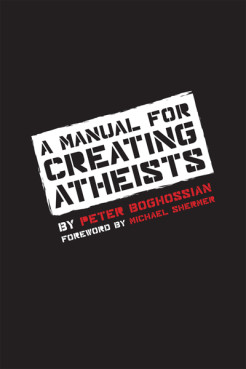A manual for creating atheists
 Having just finished Peter Boghossian’s first book, A Manual for Creating Atheists
Having just finished Peter Boghossian’s first book, A Manual for Creating Atheists, I must confess to jealousy in that it’s the most recent example of a book in the category of “books I wish I had written, and should have written, but didn’t buckle down and write”. I’d have picked a different title, but nevertheless – Boghossian’s book is a fine example of how to deploy the principles of good critical thinking towards effecting social and political change, in this case undermining epistemologies based on faith.
I was fortunate to be at The Amaz!ng Meeting (TAM) earlier this year, at which Boghossian spoke, and was at the time impressed by how he was able to distill some quite complex debates in epistemology into very succinct, and actionable, principles. Like him, I’ve spent the last 20-odd years teaching basic critical thinking to young students, and have sometimes struggled to find the language to convey what (from one end of the telescope) seem completely obvious ideas to students who appear completely mystified by both the grounds of – and the motivation for – cynicism around “knowledge” they take for granted.
Boghossian’s book does a great job in describing these contested ideas, and does so in a way that it very charitable to the political dimension of the different points of view – if I were a religious believer, I shouldn’t feel insulted by anything in his book, because it’s painstakingly fair, even when very critical. This is why I’m no big fan of the title – as Boghossian says somewhere in the text, atheism is a byproduct or happenstance result of clear thinking (and seeing as this is something I have said for a while, I reserve the right to wave my timestamped slides around, Pete!), so it’s slightly unfortunate for that, rather than the “street epistemology” the book so cogently argues for, to be highlighted.
In focusing on “street epistemology”. the book’s strength is on things that you and I can do to nudge (usually gently) those who believe strange and unwarranted things away from those beliefs, or more accurately, toward realising how they are applying quite different standards when it comes to the merits of those beliefs than they are to other beliefs they might hold, and why this is a problem.
Besides the content that deals with epistemology, argument and rhetoric, one of the strengths of Boghossian’s book is the sample dialogues he offers of (reconstructed, but real) dialogues he has had with people of faith, in which the virtues of his approach are made clear, and the value of this form of “street epistemology” are brought to life. Also of value to other teachers of philosophy to young students is a handy flowchart at the back of the book, that offers a guide for disabusing students of the relativistic urge – if I’d known how pervasive, and pernicious, that urge was going to be when I got into this all those years ago, I’d have bought the book just for that.
Regrettably, 20 years later, such a flowchart is still useful, perhaps even necessary. Thanks to books like Boghossian’s, this might not be the case another 20 years from now.


Recent Comments